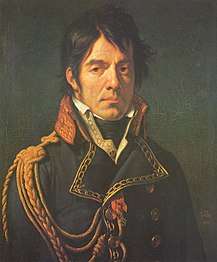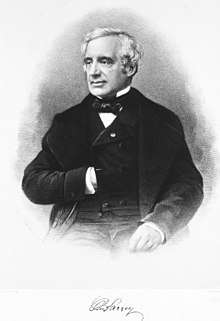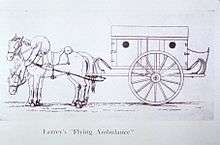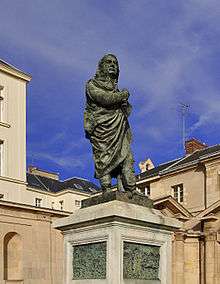Dominique Jean Larrey
| Dominique Jean Larrey | |
|---|---|
 | |
| Born |
8 July 1766 Beaudéan, Bigorre (in present-day Hautes-Pyrénées) |
| Died |
25 July 1842 (aged 76) Lyon |
| Scientific career | |
| Fields | Surgeon, Physician |
Dominique Jean Larrey (French: [larɛ]; 8 July 1766 – 25 July 1842) was a French surgeon in Napoleon's Grande Armée and an important innovator in battlefield medicine and triage. He is often considered the first modern military surgeon.
Biography
Larrey was born in the little village of Beaudéan, in the Pyrenees as the son of a shoemaker, who later moved to Bordeaux. Larrey was orphaned at the age of 13. He was then raised by his uncle Alexis, who was chief surgeon in Toulouse. After serving a 6-year apprenticeship, he went to Paris to study under Pierre-Joseph Desault, who was chief surgeon at the Hôtel-Dieu de Paris. His studies were cut short by war. Larrey went to Brest where he was appointed in the navy and gave lectures. In 1788 he was sent to Newfoundland and Labrador. In 1789 he was back in Paris and finished his thesis on Eskimos. He cooperated with Jean-Nicolas Corvisart, Marie François Xavier Bichat and Raphaël Bienvenu Sabatier in Les Invalides. In 1792, during the War of the First Coalition he joined the Army of the Rhine. In Mainz he met with Samuel Thomas von Sömmerring.
During this time, Larrey initiated the modern method of army surgery, field hospitals and the system of army ambulance corps. After seeing the speed with which the carriages of the French flying artillery maneuvered across the battlefields, Larrey adapted them as ambulance volantes ("Flying ambulances") for rapid transport of the wounded and manned them with trained crews of drivers, corpsmen and litterbearers. At the Battle of Metz (1793) Larrey successfully demonstrated the value of field ambulances. The quartermaster-general Jacques-Pierre Orillard de Villemanzy ordered prototypes to be built, after which ambulances would be supplied to all the Republic's armies. The politicians heard of this, and ordered a national contest to find the best design, thus delaying their delivery by over two years.[1] Larrey also increased the mobility and improved the organization of field hospitals, effectively creating a forerunner of the modern MASH units. He established a rule for the triage of war casualties, treating the wounded according to the seriousness of their injuries and urgency of need for medical care, regardless of their rank or nationality. Soldiers of enemy armies, as well as those of the French and their allies, were treated.
In 1794 he was sent to Toulon, where he met for the first time with Napoleon. He married the paintress Marie-Élisabeth Laville-Leroux. In Spain he fell ill and was sent back to Paris. He became professor at Val-de-Grâce but was appointed as surgeon-in-chief of the Napoleonic armies in Italy in 1797, and went to Egypt the year after. In the Battle of Acre he was wounded. In 1801 he was back in France.
Larrey was made a Commandeur of the Légion d'honneur on 12 May 1807. He joined in the Battle of Aspern-Essling, where he operated on Marshall Jean Lannes and amputated one of his legs in two minutes. He became the favorite of the Emperor, who commented, "If the army ever erects a monument to express its gratitude, it should do so in honor of Larrey", he was ennobled as a Baron on the field of Wagram in 1809. In 1811, Baron Larrey co-led the surgical team that performed a pre-anesthetic mastectomy on Frances Burney in Paris.[2] Her detailed account of this operation gives insight into early 19th century doctor-patient relationships, and early surgical methods in the home of the patient. Larrey was involved in the French invasion of Russia.

When Napoleon was sent to Elba, Larrey proposed to join him, but the former Emperor refused. At Waterloo in 1815 his courage under fire was noticed by the Duke of Wellington who ordered his soldiers not to fire in his direction so as to "give the brave man time to gather up the wounded" and saluted "the courage and devotion of an age that is no longer ours". Trying to escape to the French border, Larrey was taken prisoner by the Prussians who wanted to execute him on the spot. Larrey was recognized by one of the German surgeons, who pleaded for his life. Perhaps partly because he had saved the life of Blücher's son when he was wounded near Dresden and taken prisoner by the French, he was pardoned, invited to Blücher's dinner table as a guest and sent back to France with money and proper clothes. He devoted the remainder of his life to writing, but after the death of Napoleon he started a new medical career in the army as chief-surgeon. In 1826 he visited England, received well by British surgeons. In 1829 he was appointed in the Institut de France. In 1842 he went to Algiers, together with his son, and fell ill. Larrey died on his way back in Lyon. His corpse was taken to Paris and buried at Père-Lachaise, but his remains were transferred to Les Invalides and re-interred near Napoleon's tomb in December 1992.[3]
Larrey's writings are still regarded as valuable sources of surgical and medical knowledge and have been translated into all modern languages. Between 1800 and 1840 at least 28 books or articles were published. His son Hippolyte (born 1808) was surgeon-in-ordinary to the emperor Napoleon III.[4]
Works

- Relation historique et chirurgicale de l’expédition de l’armée d’orient, en Egypte et en Syrie. Demonville, Paris 1803.
- Mémoires de chirurgie militaire, et campagnes. J. Smith, Paris 1812. (digitalized books: Volume1, Volume 2, Volume 3)
- Richard H. Willmott: Memoirs of military surgery. Cushing, Baltimore 1814. (volumes 1–3, digitalized book)
- John C. Mercer: Surgical memoirs of the campaigns of Russia, Germany, and France. Carey & Lea, Philadelphia 1832. (volume 4, digitalized Book)
NATO Award
The Dominique-Jean Larrey Award is the North Atlantic Alliance's highest medical honour. It is bestowed annually by NATO's senior medical body, the Committee of Chiefs of Military Medical Services in NATO (COMEDS), which is composed of the Surgeons General of NATO and partner nations. It is awarded in recognition of a significant and lasting contribution to NATO multi-nationality and/or interoperability, or to improvements in the provision of health care in NATO missions in the areas of medical support or healthcare development.
References
- ↑ Gabriel, Richard A. (2013-01-31), Between Flesh and Steel: A History of Military Medicine from the Middle Ages to the War in Afghanistan, Potomac Books, Inc., p. 145, ISBN 978-1-61234-420-1, retrieved 2017-10-07
- ↑ June K. Burton, p.18–21
- ↑ Le transfert des cendres du Baron Larrey du Père-Lachaise aux Invalides 14-15 décembre 1992. Retrieved on 30 Nov 2016 from http://www.biusante.parisdescartes.fr/sfhm/hsm/HSMx1995x029x001/HSMx1995x029x001x0023.pdf
- ↑ Joseph Hamel, Historical Account of the Introduction of the Galvanic and Electro-Magnetic Telegraph (1859), page 10.
Bibliography

- Baker D, Cazalaà JB, Carli P (September 2005), "Resuscitation great. Larrey and Percy—a tale of two barons", Resuscitation, 66 (3): 259–62, doi:10.1016/j.resuscitation.2005.03.009, PMID 15990216
- Beasley AW (December 2000), "To study the healing art", The Australian and New Zealand Journal of Surgery, 70 (12): 892–7, doi:10.1046/j.1440-1622.2000.01989.x, PMID 11167578
- Bissi A (October 1989), "[Not Available]", Kos (in Italian) (49): 38–47, PMID 11629939
- Bodemer CW (July 1982), "Baron Dominique Jean Larrey, Napoleon's surgeon", Bulletin of the American College of Surgeons, 67 (7): 18–21, PMID 10315971
- Brewer LA (December 1986), "Baron Dominique Jean Larrey (1766–1842). Father of modern military surgery, innovater, humanist", The Journal of Thoracic and Cardiovascular Surgery, 92 (6): 1096–8, PMID 3537533
- Haddad FS (September 2004), "Baron Larrey: a role model to be emulated", Journal of the American College of Surgeons, 199 (3): 519, doi:10.1016/j.jamcollsurg.2004.05.266, PMID 15325631
- Burton, June K. (2001), Two "Better Halves" in the Worst of Times – Adrienne Noailles Lafayette (1759–1807) and Fanny Burney d’Arblay (1752–1840) as Medical and Surgical Patients under the First Empire (PDF) (published January 26, 2001), pp. 18–21
- Csillag I (February 1984), "Ferenc Eckstein and military surgery during the Napoleonic wars (Dominique-Jean Larrey)" [Ferenc Eckstein and military surgery during the Napoleonic wars (Dominique-Jean Larrey)], Orvosi Hetilap (in Hungarian), 125 (8): 467–70, PMID 6366693
- DIBLE JH (April 1959), "D. J. LARREY, A SURGEON OF THE REVOLUTION, CONSULATE, AND EMPIRE", Medical History, 3 (2): 100–7, doi:10.1017/s0025727300024388, PMC 1034461, PMID 13643144
- DiGioia JM, Rocko JM, Swan KG (May 1983), "Baron Larrey. Modern military surgeon", The American Surgeon, 49 (5): 226–30, PMID 6342487
- Egeblad K (1979), "[Not Available]", Dansk Medicinhistorisk Årbog (in Danish): 1979, 132–59, PMID 11628370
- Egeblad K (1978), "[Not Available]", Dansk Medicinhistorisk Årbog (in Danish): 77–123, PMID 11627862
- Fackler ML (March 1989), "Misinterpretations concerning Larrey's methods of wound treatment", Surgery, Gynecology & Obstetrics, 168 (3): 280–2, PMID 2645668
- Faria MA (September 1990), "Dominique-Jean Larrey: Napoleon's surgeon from Egypt to Waterloo", Journal of the Medical Association of Georgia, 79 (9): 693–5, PMID 2212907
- Feinsod, Moshe (2002), "The amputated leg—a tale of scientific curiosity—1792", Harefuah (published Feb 2002), 141 (2), pp. 210–2, 220, PMID 11905097
- Feinsod, M (1998), "The surgeon and the Emperor—a humanitarian on the battlefield", Harefuah (published Nov 1, 1998), 135 (9), pp. 340–3, 408, PMID 10911440
- Feinsod, M; Aharon-Peretz, J (1994), "Baron Larrey's description of traumatic aphasia", Journal of the history of the neurosciences (published Jan 1994), 3 (1), pp. 45–52, doi:10.1080/09647049409525587, PMID 11618806
- Ferrarelli, L (1954), "The physicians of the Emperor", Minerva chirurgica (published Jan 15, 1954), 9 (1), pp. 32–5, PMID 13153977
- Haas, L F (Feb 1994), "Dominique Jean Larrey (1766–1842)", J. Neurol. Neurosurg. Psychiatry, 57 (2), p. 133, doi:10.1136/jnnp.57.2.133, ISSN 0022-3050, PMC 1072437, PMID 8126493
- Burris, DG; Welling, DR; Rich, NM (2004), "Dominique Jean Larrey and the principles of humanity in warfare", Journal of the American College of Surgeons, 198 (5): 831–5, doi:10.1016/j.jamcollsurg.2003.12.025, PMID 15110817
- Hakulinen, E (1989), "The French revolution—a revolution even for health care", Lakartidningen (published Jul 12, 1989), 86 (28–29), pp. 2535–7, PMID 2674570
- HALL, D P (1959), "Our surgical heritage; Europe", Am. J. Surg. (published Jul 1959), 98 (1), pp. 130–1, PMID 13661525
- Hau, T (1982), "The surgical practice of Dominique Jean Larrey", Surgery, gynecology & obstetrics (published Jan 1982), 154 (1), pp. 89–94, PMID 7031942
- Hillemand, P; Gilbrin, E (1978), "Not Available", Histoire des sciences médicales, 12 (3), pp. 255–7, PMID 11627946
- Jellinek, E H (2002), "An unlikely aphasiologist: D J Larrey (1766–1842)", Journal of the Royal Society of Medicine (published Jul 2002), 95 (7), pp. 368–70, doi:10.1258/jrsm.95.7.368, PMC 1279946, PMID 12091516
- Jensen, J E (Jul 1981), "Napoleonic medicine", Maryland state medical journal, 30 (7): 66–8, ISSN 0025-4363, PMID 7024659
- Lefebvre, P; Cornet, A; Sicard, A (1990), "Not Available", Histoire des sciences médicales, 24 (3–4), pp. 259–63, PMID 11638332
- Lefebvre, P; Cornet, A; Sicard, A (1995), "The transfer of Baron Larrey's ashes from the Père Lachaise cemetery to the Invalides (December 14–15, 1992)", Histoire des sciences médicales, 29 (1), pp. 23–7, PMID 11640449
- Leonov, I T (1992), "D. J. Larrey and N. I. Pirogov (on the 225th anniversary of the birth of D. J. Larrey)", Vestn. Khir. Im. I. I. Grek., 149 (7–8), pp. 117–9, PMID 1341349
- Marchioni, Jean (2004), "Larrey, a legendary surgeon, a current work", La Revue du praticien (published Feb 15, 2004), 54 (3), pp. 342–5, PMID 15134246
- McIntyre, Neil (2002), "The Barons Larrey: Dominique Jean (1766–1842); Hippolyte (1808–1895)", Journal of medical biography (published Aug 2002), 10 (3), p. 185, PMID 12114954
- Mirskiĭ, M B (2007), "An outstanding field surgeon (devoted to the 240th anniversary of D. Larrey's birth", Voenno-meditsinskiĭ zhurnal (published Jan 2007), 328 (1), pp. 75–9, PMID 17436718
- Moore, A R (1978), "Preanesthetic mastectomy: a patient's experience", Surgery (published Feb 1978), 83 (2), pp. 200–5, PMID 341385
- Nau, Jean-Yves (2005), "I, Dominique Jean Larrey, baron and surgeon in chief of the Grand Army", Revue médicale suisse (published Jan 12, 2005), 1 (2), p. 186, PMID 15773223
- O'Sullivan, S T; O'Shaughnessy, M; O'Connor, T P (1995), "Baron Larrey and cold injury during the campaigns of Napoleon", Annals of Plastic Surgery (published Apr 1995), 34 (4), pp. 446–9, doi:10.1097/00000637-199504000-00020, PMID 7793796
- Pai-Dhungat, J V; Parikh, Falguni (2006), "Medical philaely (Medical theme on stamps). Dominique J. Larrey (1766–1842). Northern France Ambulance, 1918 stamp, Grenada-1970", The Journal of the Association of Physicians of India (published Oct 2006), 54, p. 811, PMID 17214278
- Quijano-Pitman, F (1997), "Surgical drainage with rubber tubes and Baron Larrey's mobile ambulances introduced by Dr. Ignacio Gama", Gaceta médica de México, 133 (3), p. 249, PMID 9303873
- Richardson, R G (1977), "Larrey – what manner of man?", Proc. R. Soc. Med. (published Jul 1977), 70 (7), pp. 490–4, PMC 1543132, PMID 331340
- Rich, Norman M; Burris, David G; Welling, David R; Rignault, Daniel P (2006), "The Larrey legacy: two hundred years on", Current Surgery, 63 (2): 119–21, doi:10.1016/j.cursur.2005.12.008, PMID 16520113
- Rüttimann, B (1979), "Larrey's amputation technic", Gesnerus, 36 (1–2), pp. 140–55, PMID 381112
- Skandalakis, Panagiotis N; Lainas, Panagiotis; Zoras, Odyseas; Skandalakis, John E; Mirilas, P (2006), ""To afford the wounded speedy assistance": Dominique Jean Larrey and Napoleon", World Journal of Surgery (published Aug 2006), 30 (8): 1392–9, doi:10.1007/s00268-005-0436-8, PMID 16850154
- Soubiran, A (1966), "Larrey. The providence of soldiers (1766–1842)", La Presse médicale, 74 (34), pp. 1785–6, PMID 5328565
- Stembrowicz, W (1995), "Dominique Jean Larrey (1766–1842) the author of the work: On wounds of the pericardial sac and heart", Archiwum historii i filozofii medycyny / Polskii Towarzystwo Historii Medycyny i Farmacji, 58 (3), pp. 311–28, PMID 11624807
- James J. Walsh, "Dominique-Jean Larrey", Catholic Encyclopedia
- Wangensteen, S D; Wangensteen, O H (1971), "Successful pre-Listerian antiseptic management of compound fracture: Crowther (1802), Larrey (1824), and Bennion (ca. 1840)", Surgery (published Jun 1971), 69 (6), pp. 811–24, PMID 4931133
- Welling, David R; Burris, David G; Rich, Norman M (2006), "Delayed recognition – Larrey and Les Invalides", J. Am. Coll. Surg. (published Feb 2006), 202 (2), pp. 373–6, doi:10.1016/j.jamcollsurg.2005.08.024, PMID 16427565
- Wilson, T (1997), "The ambulance – Larrey's legacy", Scalpel & tongs : American journal of medical philately, 41, pp. 82–3, PMID 11619525
- Wybieralski, A (1966), "Dominique Jean Larrey (1766–1842) On the 200 anniversary of his birth", Archiwum historii medycyny, 29 (3), pp. 313–20, PMID 5335562
- Zimmerman, L M (1968), "Humanity and compassion in medicine (Ambroise Paré, Baron Dominique-Jean Larrey)", The Chicago Medical School quarterly, 27 (4), pp. 233–4, PMID 4913343
- "The immediate care of the eyes in Napoleonic France", Anaesthesia (published Apr 1976), 31 (3), p. 439, 1976, doi:10.1111/j.1365-2044.1976.tb12341.x, PMID 776029
External links
| Wikimedia Commons has media related to Dominique Larrey. |